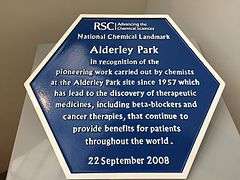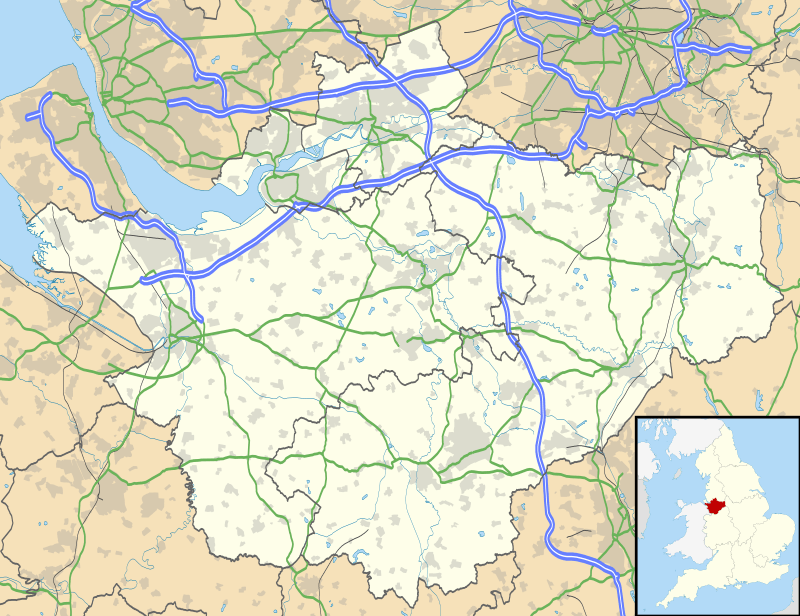Alderley Park
Alderley Park was a country estate at Nether Alderley, Cheshire, England, between Macclesfield and Knutsford. It was the residence of the Stanley family of Alderley from the 1500s. It became the headquarters of ICI Pharmaceuticals in the 1950s. It was purchased from AstraZeneca by Bruntwood in 2014. The site has an international reputation as a home for bio and life sciences.
| Alderley Park | |
|---|---|
Manchester Science Parks | |
 National Chemical Landmark at Alderley Park | |
 Location within Cheshire | |
| Former names | ICI Pharmaceuticals Division, Zeneca Pharmaceiticals, AstraZeneca |
| General information | |
| Type | Science park, former ICI research centre |
| Address | Nether Alderley, Cheshire, SK10 4TG |
| Coordinates | 53.271°N 2.233°W |
| Elevation | 95 m (312 ft) |
| Completed | 1957 |
| Inaugurated | 1957 |
| Client | ICI Pharmaceuticals |
| Dimensions | |
| Other dimensions | 21.5 hectares |
The Aldlerley New Hall was constructed in brick with a stone facade for the 7th Baronet Stanley. Building started in 1818 on a site in the south of the park. The new house grew to a size of sixty bedrooms and six entertaining rooms, of which only one room, with its oak panelling and coats of arms intact, remains. Behind the house a walled garden and a water garden were created and the mill pond enlarged. In 1931, however, the house was severely damaged by fire and left empty for nearly twenty years until converted in 1950 by Imperial Chemical Industries (ICI) to serve as the base for their new pharmaceutical division. The gardens and some outbuildings have been preserved and many thousands of trees planted.
History
The manor of Over Alderley came into the Stanley family when heiress Elizabeth Weever married John Stanley, a brother of the Earl of Derby. In the 1580s John Stanley's descendant, Thomas Stanley, built a mansion house on a moated site near the mill at Nether Alderley. Thomas died in 1591.
The adjacent manor of Nether Alderley had been confiscated by the crown in 1508 from the estate of Sir William Stanley after his conviction and execution for supporting Perkin Warbeck. It was sold in 1556 to Sir Edward Fitton of Gawsworth who sold it on for £2000 to Thomas Stanley, jnr in 1602.[1] Thomas was knighted by King James in 1603. The Stanley family subsequently occupied the hall for around two hundred years until it was severely damaged by fire in 1779; part of the old hall survives, dating from the 17th century.[2] The 7th Baronet then commissioned a new hall to be constructed in 1818, in the south of the estate on a site then occupied by Park House.
The new hall was subsequently occupied by further generations of the Stanley family until 1931, when it too was damaged by fire during the occupation of Edward Stanley, 6th Baron Stanley of Alderley and had to be partially demolished and left unoccupied. The sixth Lord's finances had suffered from the effects of two expensive divorces, gambling losses and death duties and in 1938 he decided to sell the estate piecemeal, involving the disposal of 77 farms and 166 houses. No offers were received for the hall itself and it stood empty for nearly twenty years.
Edward Stanley, 4th Baron Stanley of Alderley hosted Prime Minister Herbert Asquith and his cabinet minister Winston Churchill at Alderley Park in the early 1900s. Churchill planted a sweet chestnut tree near the Tenant's Hall, known since as the Churchill Tree.[3]
Structure
The site is north-east of the Monk's Heath Crossroads between the A537 and A34. Before the M6 opened in the early 1960s, the A34 was the main thoroughfare to the north-west. The ICI site was accessed to the west from the former A34; the A34 Alderley Edge Bypass opened on 19 November 2010.
Business use
ICI
In 1950 the dilapidated hall and 350 acres (140 ha) of surrounding parkland were purchased, with planning permission to develop, by ICI Pharmaceuticals for £55,000. Work began in 1957 on a site by Radnor Mere (the enlarged mill pond) to provide office and laboratory facilities, initially for ICI and latterly for AstraZeneca (after ICI Pharmaceuticals became Zeneca Pharmaceuticals in 1993), and which came to house some 3,500 staff. It became a global lead centre for cancer research and a number of anti-cancer treatments were developed at the site including Nolvadex, Zoladex, Casodex, Arimidex and Iressa. The ground-breaking anaesthetic Diprivan was discovered in the laboratories in 1973.

In 1963 a new Alderley House was built as the commercial headquarters (and was demolished in 2015). Work on the latest modification of the Alderley Old Hall began in 1963, and incorporates a surviving part of the previous buildings. Originally the Tenant's Hall (and used a hospital in the Great War), this building is now named the Sir James Black Conference Centre in honour of the Nobel Prize-winning discoverer of beta-blockers. The gardens and the woodlands have been restored and the nearby Grade II listed Home Farm buildings preserved. The latter includes coach-houses, cottages and barns of hand-made English orange brick and a six-sided columbarium or dovecote.[4][5]
AstraZeneca
In March 2013, AstraZeneca announced plans to cease R&D work at Alderley Park. A total of 1,600 jobs were to be relocated over three years, mainly to Cambridge, but the company planned to continue non-R&D work at the site.[6] In March 2014, Alderley Park was purchased by Manchester Science Parks – a partnership between Manchester's academic centres and local councils, and investment company Bruntwood.[7]
Redevelopment
In February 2016, planning consent was granted for a £160m masterplan to re-develop the Park which will include significant investment into re-purposing the bioscience campus to one of multiple occupancy, up to 275 homes, a farm shop, village shop, gastropub and new leisure facilities. Construction of the first two phases of houses by PH Homes and PJ Livesey commenced in 2017.[8] Robert Adam, one of the architects for PH Homes' Alderley Park development, was awarded the 2017 Driehaus Architecture Prize at the University of Notre Dame, the highest value architecture award in the world.[9]
As of 2017, over 150 companies are based at Alderley Park, including the Medicines Discovery Catapult[10] and the AMR Centre.[11]
See also
References
- "Stanley of Alderley". Retrieved 10 October 2012.
- Historic England. "The Old Hall (1139591)". National Heritage List for England. Retrieved 20 August 2017.
- "Alderley Park / The Stanley Family - Nether Alderley Parish Council, Cheshire, UK". www.netheralderleyparish.com. Retrieved 22 February 2020.
- Historic England. "Training Centre and Stores at Alderley Park (1139596)". National Heritage List for England. Retrieved 20 August 2017.
- Historic England. "Dovecote at Alderley Park (1221289)". National Heritage List for England. Retrieved 20 August 2017.
- BBC News: AstraZeneca axes 700 jobs in Cambridge move (accessed 19 March 2013)
- "Alderley Park 'will remain flagship bioscience location'". PMLive. 12 March 2014. Retrieved 20 August 2017.
- "PH's Alderley Park homes start at £735k". Place North West. Retrieved 3 May 2018.
- "Architect For Alderley Park Wins Major Prize". Alderley Park. Retrieved 3 May 2018.
- "Contact Us". Medicines Discovery Catapult. Retrieved 20 August 2017.
- "Antimicrobial Resistance Centre". www.amrcentre.com. Retrieved 29 September 2017.
Further reading
- "The story of Alderley Edge". Archived from the original on 25 February 2012. Retrieved 12 October 2012.
- "Alderley Park/The Stanley family". Nether Alderley Parish Council. Retrieved 12 September 2012.
- "Stanley of Alderley". Manx Notebook. Retrieved 12 September 2012.
- Hill, George B. Alderley Park Discovered Carnegie Publishing 2016
External links
- Official website
- Parklands, Alderley Park at bruntwood.co.uk